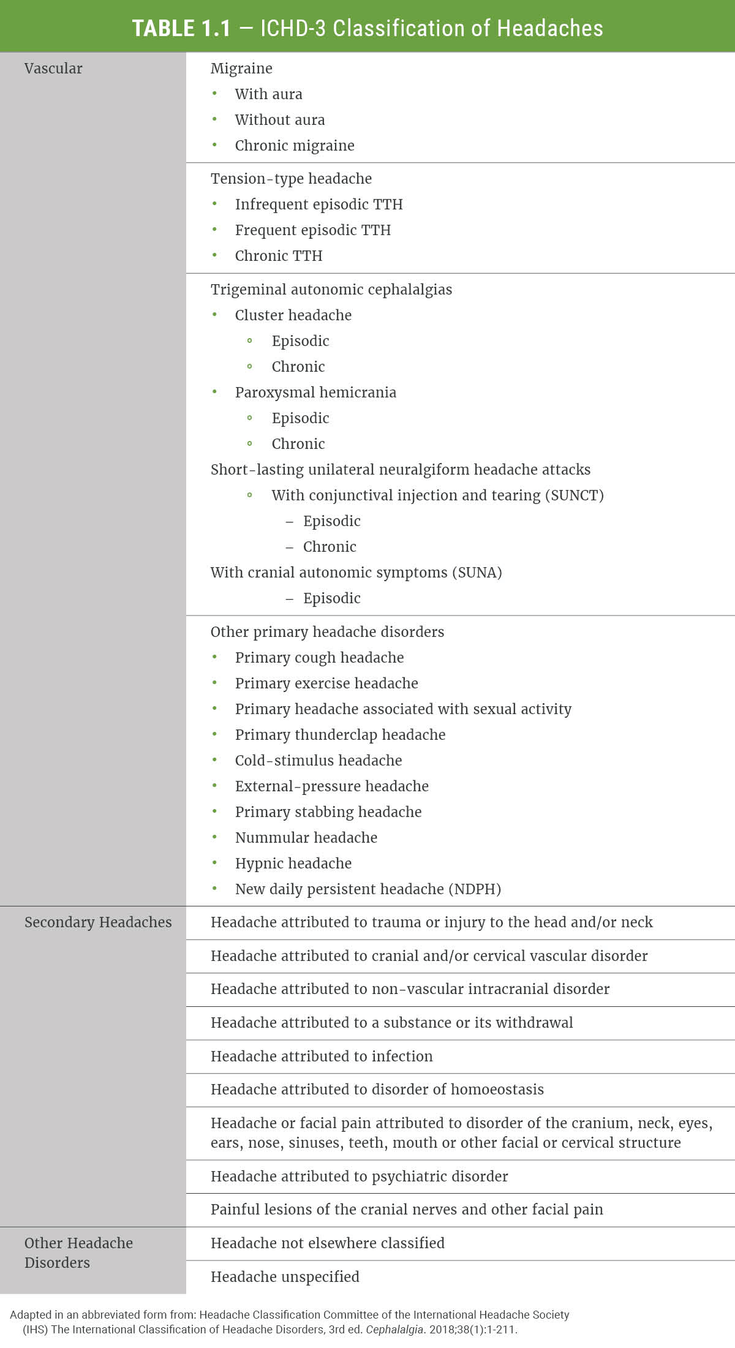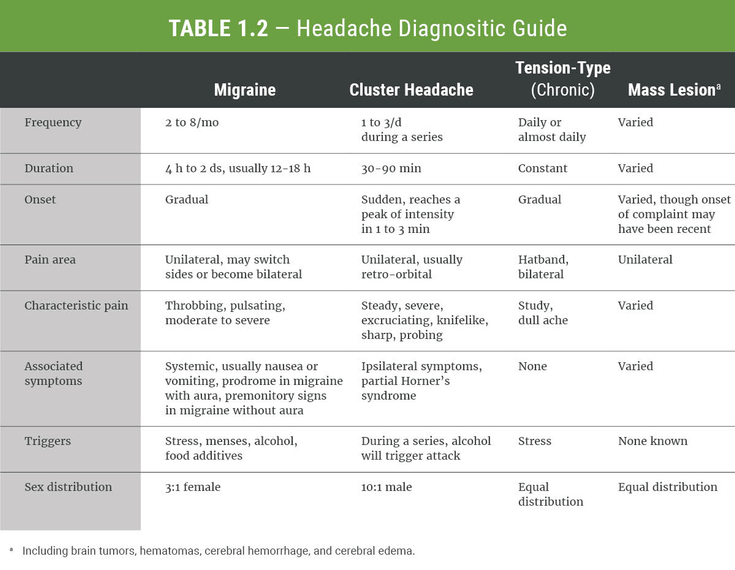Classification
Classification system for headaches
To facilitate establishing the diagnosis of headache, an understanding of the classification of the various headache types is essential. In the 1960s, the Ad Hoc Committee of the National Institutes of Health undertook the first rigorous attempt at defining an extensive classification system for headache. In 1988, the International Headache Society (IHS) developed comprehensive classification and diagnostic criteria, the International Classification of Headache Disorders or ICHD, now known as ICHD-I. While the ICHD-I was based largely on expert opinion, scientific evidence played a larger part in the two subsequent versions, the ICHD-II (released in 2004) and ICHD-3 (the current version, released in 2018).
The ICHD-3 classifies headaches into 14 categories (Table 1-1) – four “primary” headaches categories, nine “secondary” headache categories (i.e., headaches due to an identifiable underlying condition), and one…
To continue reading
Log in or register to continue reading. It's free!
OR
By signing up to create an account, I accept Healio's Terms of Use and Privacy Policy.
Classification system for headaches
To facilitate establishing the diagnosis of headache, an understanding of the classification of the various headache types is essential. In the 1960s, the Ad Hoc Committee of the National Institutes of Health undertook the first rigorous attempt at defining an extensive classification system for headache. In 1988, the International Headache Society (IHS) developed comprehensive classification and diagnostic criteria, the International Classification of Headache Disorders or ICHD, now known as ICHD-I. While the ICHD-I was based largely on expert opinion, scientific evidence played a larger part in the two subsequent versions, the ICHD-II (released in 2004) and ICHD-3 (the current version, released in 2018).
The ICHD-3 classifies headaches into 14 categories (Table 1-1) – four “primary” headaches categories, nine “secondary” headache categories (i.e., headaches due to an identifiable underlying condition), and one miscellaneous category that includes otherwise non-categorized or unspecified headaches. Although common types of secondary headaches are discussed in dedicated sections, the focus in this module is on the three main types of primary headache, including:
- Migraine
- Trigeminal autonomic cephalalgias, particularly cluster headache
- Tension-type headache.
Migraine
Migraine is the most common primary headache disorder. According to the 2019 Global Burden of Disease Study, migraine is the second most common cause of disability worldwide (first in young women). Migraine is further divided into two major subtypes:
- Migraine without aura, also known as common migraine, characterized by specific features, duration, and symptoms
- Migraine with aura, characterized by transient focal neurological symptoms (the “aura”) which precede or occasionally co-occur with the headache.
It is possible for a patient to have both episodes of migraine with aura and episodes without aura. Chronic migraine is an independent category applied to patients who experience a headache on at least 15 days per month for more than 3 months, and a migraine headache on at least 8 days per month.
Patients with migraine may also experience a “prodromal” or “postdromal” phase (before the onset of headache or after the headache resolves, respectively) characterized by symptoms like hyper- or hypoactivity, mood changes, food cravings, fatigue, and neck stiffness and/or pain.
Trigeminal Autonomic Cephalalgias
Trigeminal autonomic cephalalgias (TACs) are a group of headache disorders characterized by unilateral headache and, commonly, ipsilateral cranial parasympathetic autonomic features. Rarely, a migraine-like aura may occur. The ICHD-3 divides TACs into the following subcategories:
- Cluster headache, characterized by severe and unilateral pain in any combination of orbital, supraorbital, and temporal sites lasting 15-180 minutes; further subdivided into episodic and chronic types
- Paroxysmal hemicrania, also characterized by severe unilateral orbital, supraorbital, and/or temporal pain, with a shorter duration (2-30 minutes); also subdivided into episodic and chronic types
- Short-lasting unilateral neuralgiform headache attacks (SUN), unilateral headaches of moderate to severe intensity lasting seconds to minutes; subdivided into SUN with conjunctival injection and tearing (SUNCT) and SUN with cranial autonomic symptoms (SUNA), each of which has both episodic and chronic forms
- Hemicrania continua, a persistent unilateral headache responsive to therapeutic doses of indomethacin; subdivided into the remitting subtype (headache interrupted by remissions lasting 24 hours or more) and the unremitting subtype (continuous pain with remissions never lasting more than 24 hours).
Tension-Type Headache
Tension-type headache (TTH), previously also called “muscle contraction” headache, is a common and morbid category of primary headache. Although initially considered primarily psychogenic, TTH is now believed to have a neurological basis, although its etiology is not fully understood. This category can be further divided into:
- Episodic, itself further divided into infrequent (<1 headache per month) and frequent (1-14 headache days per month)
- Chronic (≥15 headache days/month).
Infrequent episodic TTH occurs in almost everyone and generally does not require medical attention. Most people experiencing frequent episodic TTH will use simple, over-the-counter analgesics to obtain relief. Chronic tension-type headaches are more serious, and are usually linked to depression or anxiety. Most patients seeking a physician’s help with their headaches are experiencing chronic TTH.
Conclusion
Many types of primary and secondary headache have highly morbid consequences. Management is dependent on the etiology, and immediate treatment may be indicated. A headache diagnostic guide is provided to facilitate diagnosis in a clear, concise manner (Table 1-2). A thorough headache history and appropriate diagnostic testing will aid in confirmation of the diagnosis (see DIAGNOSIS for a more detailed discussion).
References
- Diamond, ML. Diagnosing and Managing Headaches, 8th ed. Professional Communications Inc. 2023
- Ad Hoc Committee. Classification of headache. JAMA. 1962;6:717.
- Headache Classification Committee of the International Headache Society (IHS) The International Classification of Headache Disorders, 3rd ed. Cephalalgia. 2018;38(1):1-211.
- Steiner TJ, Stovner LJ, Jensen R, et al. Migraine remains second among world’s causes of disability, and first among young women: findings from GBD2019. J Headache Pain. 2020;21(1):137.





